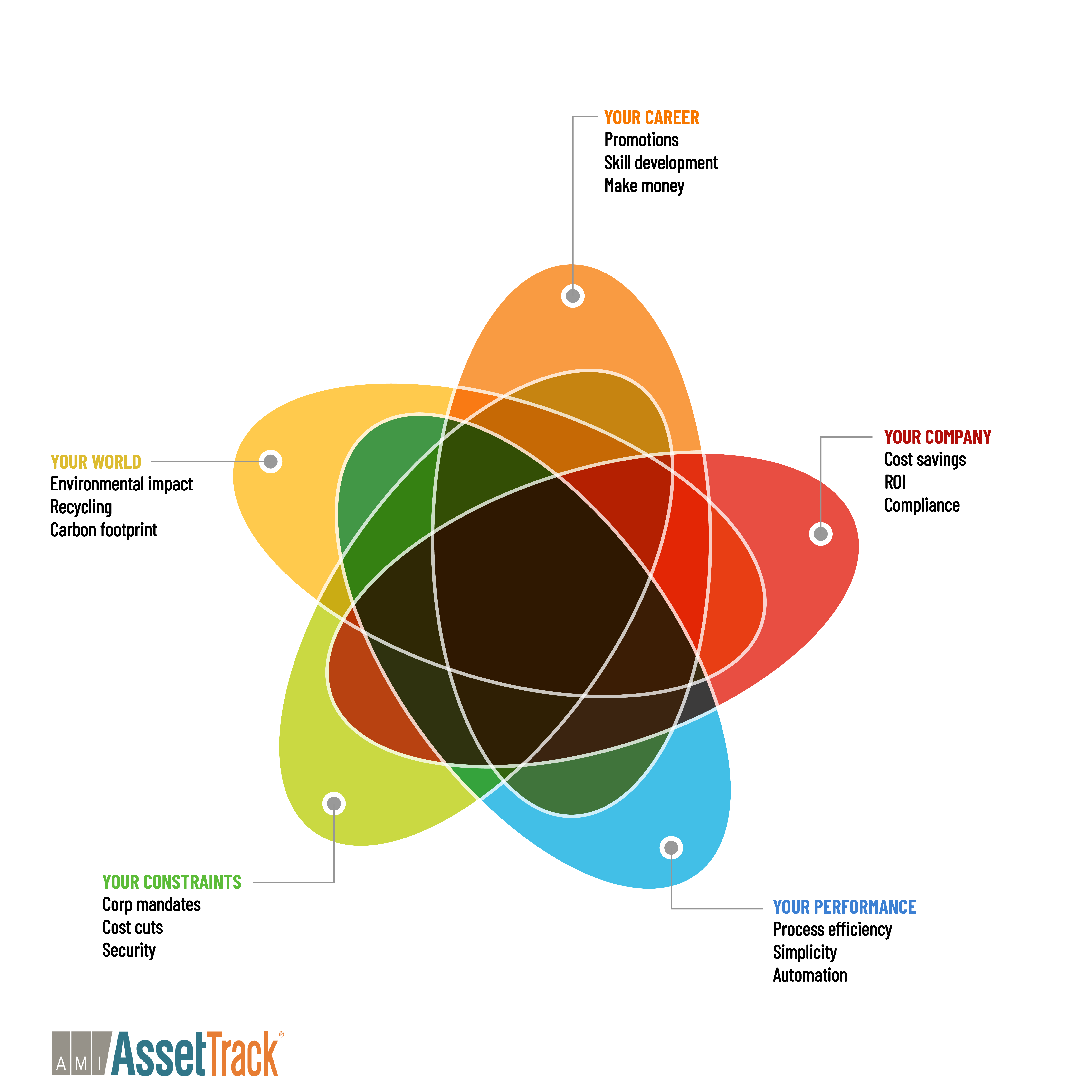At work, do you ever feel like you’re trying to navigate a maze blindfolded, with obstacles coming at you from every direction? You may be focused on getting promoted, acquiring new skills, worrying about the latest budget cuts, or hearing about the new environmental program that corporate rolled out. But, that’s how work happens – everything, everywhere, all at once and the reality is nothing is a clean overlap. We all experience various elements of all these things throughout our careers. Regardless of where you, your team, or your company are on the diagram below, a central stabilizing component is Hardware Asset Management, also known as HAM (well not really but it is more fun to say HAM).
With all these inputs and all the requests on your time and resources, can things get easier? As we progress into the future of AI and HAM, these needs don’t change, but the tools we use do, and there’s a ray of hope to simplify our jobs. Laying the foundation TODAY for a successful tomorrow is critical. Understanding where you and your company are on the diagram can help streamline operations, save you time, and ultimately save you money.

Why is Hardware Asset Management important?
If you are reading this, chances are you are in the world of HAM or you know that it ultimately affects you in one way or another. Every organization has assets and when there are assets, they require management and that’s where Hardware Asset Management comes in. By managing assets properly, you can provide significant value to your business. You can increase operational efficiency, manage risk by keeping track of assets that have sensitive data, optimize the company’s cost, and spend, and use the data to make strategic business decisions. To succeed and drive value you need to create a harmonious HAM system. You need the people to do the work/make decisions, the processes that structure and streamline operations and technology/tools to support and amplify people’s efforts. Which is where AI will play a part in making this more efficient.
What’s AI got to do with it?
Your world and the world around you are constantly changing and advancing. AI being one of the main driving factors. If you haven’t had ChatGPT write up an email or helped you write a presentation, then you are probably in the minority. AI is changing the world as we know it, making things easier but also leaving humans to wrestle with questions like “will AI take over my job?” or “how can AI help me in my job?”. The truth is, there is a ton of data in the world. Too much data for any one person to understand and synthesize. But, when data is fed into AI models, the machine can quickly synthesize, parse, and coordinate the information into patterns and details that we can understand. AI gives us the ability to quickly see answers and data patterns that we’d never have been able to see previously.
How do I use AI in Hardware Asset Management?
So now that we know that AI can help you, let’s talk about how you can use it in HAM. In HAM you want to know what assets you have, what assets you need to buy, where assets are and what assets need to be retired. There are so many assets to keep track of and using AI to help support us in this will make your life much easier. AI is used in HAM to help track all of the various stages of assets from purchasing to destruction. When AI can help streamline and automate these processes, it allows for less human error, which in turn, ensures cleaner and more accurate data. Now let’s imagine how AI can go above and beyond to use that data.
Example 1: Say for instance that you’re interested in reducing your stock dwell time – the number of days an asset sits before it gets deployed to a user. With an AI in place, you can generate a report six months after implementation to see how much you’ve shortened this time – say, from 60 days to 30, which in turn reduced idle stock by 10%, saving your company x amount of money.
Example 2: You can also use AI to hold your vendors accountable. Imagine you have a Service Level Agreement (SLA) with a maintenance vendor. They’ve agreed in the SLA to turn around assets sent to them within 7 days. Leveraging AI technology, you can generate reports that will show you just how long maintenance is taking to ensure that your vendors are sticking to the terms they’ve agreed to, and that your assets have the minimal amount of ‘downtime’.
As we speed towards an AI-assisted future, the importance of HAM becomes even more pronounced. While your needs remain the same, the tools we use should be evolving. Building a robust HAM system today is not just about efficiency-it’s about future-proofing your operations and turning your data into decisions. Embrace the power of AI in HAM and unlock a future where your assets are managed with accuracy and efficiency, bringing your organization toward further success.


